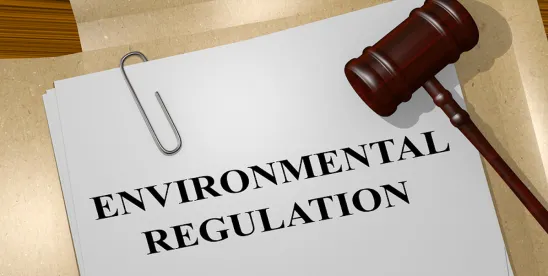On May 1, the Council on Environmental Quality (CEQ) published the final Phase 2 rule overhauling the National Environmental Policy Act (NEPA) implementing regulations. The final rule, titled the “Bipartisan Permitting Reform Implementation Rule” (Phase 2 Rule), will apply to all actions starting the NEPA processes beginning after July 1, 2024, and the agencies have discretion to apply to NEPA reviews that are currently underway.
The Final Rule reflects potential tension between two of CEQ’s objectives – place more substantive requirements on NEPA reviews, including more comprehensive review of climate change and environmental justice impacts, yet provide more efficient NEPA reviews (especially for projects such as renewable energy and infrastructure). The Phase 2 rule codifies changes made by the bipartisan Fiscal Responsibility Act (FRA) of 2023, which amended key provisions of NEPA to improve the federal permitting process for energy projects. While some provisions such as time and length limits on the review process and expanded use of categorical exclusions are likely supportive of this goal, other provisions, such as specific requirements for evaluating climate change effects and enforceable mitigation measures, may result in broader and lengthier reviews.
Changes That May Help Streamline NEPA Reviews
a. Expanded Opportunity for Categorical Exclusions
Categorical exclusions are types of actions that are exempt from further NEPA review because an agency has determined they do not cause significant effects to the environment. Under the Phase 2 rule, an agency can establish its own categorical exclusions or adopt another agency’s categorical exclusion for projects that are “substantially similar.” The final rule adds a requirement that agencies include a brief description of the proposed action or categories of proposed actions to which the agencies intend to apply the categorical exclusion. Cross-agency adoption of categorical exclusions is expected to reduce time for permit approvals and may be particularly useful for renewable energy development projects that often require permits from multiple agencies like the Department of Energy and the US Army Corps of Engineers.
b. Page and Time Limits with Court Review
The final rule codifies the page and time limits for environmental review documents consistent with the FRA. An Environmental Assessment (EA) must be completed within one year and an Environmental Impact Statement (EIS) must be completed within 2 years. Additionally, an EA must be under 75 pages long and an EIS must be between 150 and 300 pages long. These changes are intended to provide certainty when project planning, but provide for extensions when needed.
In addition, consistent with the FRA, a project applicant can file a challenge in federal court if an agency misses a deadline, and the court can set an enforceable compliance schedule, as a remedy.
Other aspects of the Phase 2 rule that are likely to help streamline NEPA reviews include provisions that:
- Require agencies to establish a schedule for NEPA review in consultation with the applicant and make EIS schedules publicly available;
- Allow applicants and contractors to draft EISs (in addition to EAs), with independent review from the agency;
- Encourage incorporation by reference to earlier relevant NEPA documents and allow agencies to adopt other agencies’ NEPA documents; and
- Require comments to be as specific as possible.
New Substantive Requirements That May Result in Broader and More Complex NEPA Reviews
c. Characterization of NEPA as Action-Forcing
One of the major changes in the Phase 2 rule is a shift in the characterization of NEPA, which has long been applied by the regulations and courts as a procedural statute that requires agencies to “look and listen” and consider impacts, to one that is substantive and action-forcing in agency decisionmaking. Several new provisions in the Phase 2 rule indicate that agencies must use NEPA reviews to select environmentally beneficial alternatives. For example, new provisions require the agencies to identify alternatives that avoid or minimize environmental effects and “use all practicable means” “to restore and enhance the quality of the human environment and avoid or minimize any possible adverse effects of their actions upon the quality of the human environment.”
d. Mitigation Measures
One significant change under the Phase 2 rule is the requirement for enforceable mitigation measures where a proposed action’s finding of no significant impact is based on the implementation of the mitigation measure. The final rule preamble also clarifies that agencies may approve proposals with unenforceable mitigation measures so long as these measures were not used in the agency’s determination of significant impact. The agency must identify the authority for enforcing the mitigation measure, such as in permit conditions or via other agreements.
Additionally, where the significance determination is based on the implementation of mitigation measures and the agency incorporates the mitigation measures into its decision document, the lead or cooperating agency is required to publish a monitoring and compliance plan which must include a timeframe for implementing the mitigation measures and consequences for failing to comply with mitigation measures. This requirement differs slightly from the proposed rule in that it does not require a monitoring and compliance plan for every decision that includes mitigation measures.
e. Increased Consideration of Environmental Justice and Climate Change
The Phase 2 rule implements Biden-Harris Administration priorities to address environmental justice (EJ) and climate change. The Phase 2 rule expands the definition of “effects” to explicitly include EJ and climate change impacts. It requires consideration of EJ and climate change effects at multiple stages of the NEPA process, including when determining the level of NEPA review, conducting public outreach, identifying the environmentally preferable alternative, evaluating the environmental effects of the action, and identifying mitigation requirements. Where effects on climate change must be considered, an agency will need to consider both the reasonably foreseeable effects of proposed projects on climate change and the effects of climate change on the proposed action and their alternatives. Where effects on environmental justice communities must be considered, an agency will need to consider “disproportionate and adverse effects on communities with environmental justice concerns.”
When evaluating the proposed action with alternatives, agencies must also consider conflicting regional, state, tribal, or local plans and policies that address climate change. Although agencies have considered EJ and climate change impacts in NEPA reviews in recent years, CEQ’s final rule emphasizes these policy objectives in a manner that heightens their consideration and emphasis for agency decision-making and may result in the prioritization of certain actions over others.
Another mechanism in the Phase 2 rule to increase emphasis on EJ effects is the requirement for each agency to identify a “Chief Public Engagement Officer” who is responsible for facilitating community engagement. The Phase 2 rule also increases an agency’s public engagement obligations, including increased opportunity to comment on a draft EA.
Other aspects of the Phase 2 rule that may result in broader or more complex reviews include provisions that:
- Allow for evaluation of alternatives outside of the action agency’s jurisdiction;
- Require expanded public and governmental engagement, particularly for EJ communities;
- Consider a broader range of factors in evaluating significance for purposes of determining appropriate level of NEPA review, including proximity to sensitive resources or vulnerable communities; and
- Consistent with the FRA, require agencies that are relying on programmatic environmental reviews that are over 5 years old to re-evaluate the analysis to confirm analysis remains valid.
If you have a project that may trigger NEPA review, engage counsel early on to advise you on how to navigate these regulatory changes.









 />i
/>i

